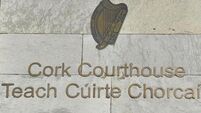Gardaí investigate narco-subs used by cartels to smuggle cocaine into Ireland

A photo issued by An Garda Siochana showing €8.4m worth of cocaine which had been flown in on a private plane. Drug traffickers are now looking at new methods of transporting cargo.
Gardaí are investigating how semi-submersibles, or ‘narco-subs’ are being used by crime cartels to potentially traffic drugs into and through Ireland.
As traffickers become more aware of cargo ships being targeted by law enforcement — such as in multiple recent cases off the south coast, including the historic MV Matthew cocaine seizure — they are increasingly using 'narco-subs' in a bid to evade detection.
Built in the jungles of South America, commonly in Colombia, Guyana, and Suriname, which border northern Brazil, they are constructed with fibreglass and wood, packed with drugs, and then sailed down rivers and out to sea.
Travelling low in the water, mostly just below the waterline, they are designed to evade detection.
Narco-subs are increasingly being intercepted in the Mediterranean, and gardaí are examining how cartels may be using them to access Irish waters and the lucrative European drug market.
Narco-sub design is becoming increasingly sophisticated, with the first long-distance unmanned narco-sub, designed to be operated remotely with a Starlink satellite connection, intercepted in July by the Colombian navy.
Although empty at the time, it reportedly had the capacity to carry 1.5 tonnes of cocaine and to travel up to almost 1,300km.
Remote-control drug trafficking boats have also been seized in the Mediterranean, but these were only used for short distances.
A mass graveyard of narco-subs is believed to lie at the bottom of the Atlantic near the Azores and the Canary Islands, being deliberately sunk after unloading their cocaine cargo at sea, the BBC reports.
And last year, a semi-submersible was intercepted in the Pacific carrying five tonnes of cocaine and five people onboard on a suspected journey to Australia — where cocaine can be sold at a price some six times higher than in the US — which remains the cartels' most lucrative cocaine market.
That vessel, and another two semi-submersibles caught in the same operation, were capable of travelling from Colombia to Australia without stopping to refuel, authorities said.
These semi-submersibles were intercepted as part of 'Orion', a multinational naval operation of which Ireland was a member.
The global operation seized 1,400 tonnes of drugs, including 225 tonnes of cocaine, and led to the arrest of more than 400 people.
“They [drug traffickers] are adapting all the time, when they know cargo ships are being watched, they’ll look for other trafficking methods,” a source in Ireland said.
Irish authorities have also searched large cargo vessels strongly suspected of smuggling cocaine from South America into Europe, but despite extensive searches over weeks, sometimes no illicit cargo was found.
But cargo such as cocaine can be thrown overboard and sunk, or burned and destroyed quickly once someone on board the ship sees authorities approach, a source said.
Attempts were made to burn the cocaine aboard the MV Matthew, and they may have succeeded had the Army Ranger Wing not risked their own safety by abseiling from a helicopter onto the ship as it tried to avoid the authorities in stormy waters, a source said.
International police co-operation is facilitating the increased interception of cartel trafficking routes, with international organisations including the Maritime Analysis and Operations Centre – Narcotics, or MAOC (N), an initiative by nine European countries, including Ireland, playing pivotal roles.
Earlier this summer, a semi-submersible was seized in Brazil that was being prepared to cross the Atlantic to Europe, carrying a significant amount of cocaine.
This is believed to be linked to the semi-submersible seized last March by Portuguese authorities carrying more than six tonnes of cocaine.
The equipment on both vessels was manufactured in the northern Brazilian state of Pará, which is traversed by the Amazon River.
And they are believed to be linked to a specific cartel which trafficks large volumes of cocaine from remote areas of Brazil to Europe.
And in May, MAOC (N) co-organised an international conference in Cartagena, Colombia, bringing together more than 100 experts from 19 countries to address the growing threat of semi-submersible vessels in cross-Atlantic drug trafficking.
The most recent United Nations’ World Drug Report 2025, published in June, found that in 2023, illegal production of cocaine increased by around one-third from the previous year.
However, global cocaine seizures also reached a record high in 2023 across all regions, with a 68% increase in drugs seized between 2019 and 2023.
But the number of cocaine users have also risen, with 25m users globally in 2023, up from 17m a decade earlier, the UN found.










